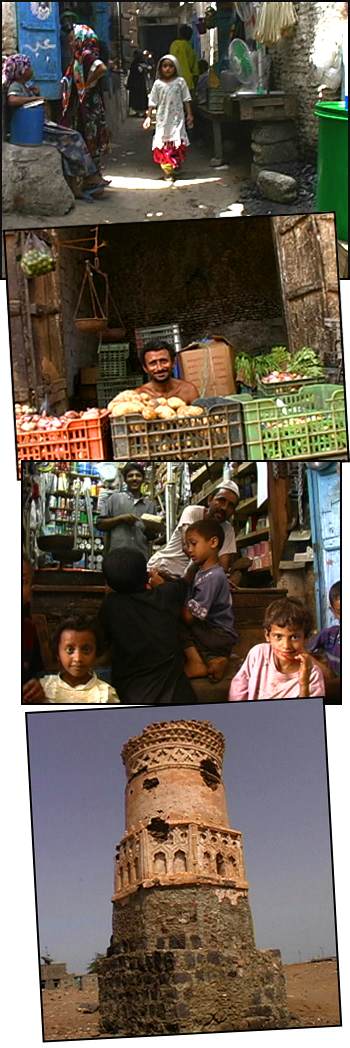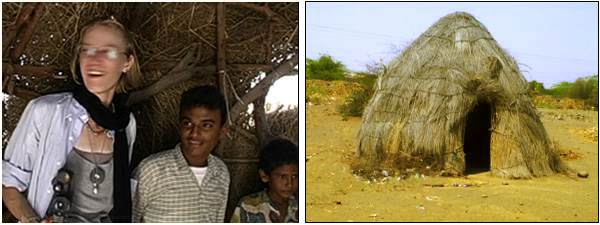|
Temples and ruins sleep in the desert, waiting for a camera to record them. Markets and meadows are full of colors and textures and mountain ranges are waiting to inspire the adventurous. This land contains a living history of life as it was thousands of years ago. The beauty is overwhelming and the people are genuinely friendly. Even an amateur could look like a seasoned travel photographer. |
 "Surrah! Surrah! Take a picture! Take a picture!" the children offered us smiles everywhere we went. The faces of Yemeni children are some of the most angelic faces in the world. The small boys, with their jackets and jambias, are tiny copies of their fathers. The girls [see left] under the age of ten look like colorful flowers skipping through doorways and suq paths. Most girls are donning the black over-robes of a proper Islamic woman by age fifteen.
"Surrah! Surrah! Take a picture! Take a picture!" the children offered us smiles everywhere we went. The faces of Yemeni children are some of the most angelic faces in the world. The small boys, with their jackets and jambias, are tiny copies of their fathers. The girls [see left] under the age of ten look like colorful flowers skipping through doorways and suq paths. Most girls are donning the black over-robes of a proper Islamic woman by age fifteen."Mumkin?" I asked a small girl in the suq, showing her my camera, "Can I take your photo?" The girl looked to her mother. The mother nodded and the little one smiled up into my camera lense. Click! "Gammil ! Shuckran," I smiled, "Beautiful, thank you." Suqs are a fantastic opportunity for photography. The merchants are friendly and proud of their wares. It doesn't take much urging to get a proprietor to pose with his shop. ViewZone's Photographs Most of the images in this Expedition series were shot using digital cameras. Sky prefers a mega-pixel Polaroid PCD-3000 while Gary uses a GL-1 Cannon Video. We download our images to a titanium G-4 Laptop (Apple) and update the web site from remote phones whenever we can find a phone jack that fits. Digital images don't require expensive film, which can be old or go bad in the hot climates. Sky shoots hundreds of pictures every day and save only a small portion of them. The only thing she has to worry about is getting fresh AA batteries -- which can be a problem in small villages. If you decide to bring film to Yemen remember there are temperature extremes and refrigeration is rare. Dust is also a thing to consider. A good lens brush will save lots of otherwise spotted pictures as the bright sun seems to amplify every microscopic speck of lens dust. Big cities like Sana'a, Taiz and Aden will have camera stores with fresh batteries and film and even excellent film processing. The ViewZone crew packed their equipment in crush proof cases -- a must for those bumpy Toyota rides. When we were hiking, we usually packed only enough film for a day or two -- usually 2 hours of video and about 60 still pictures. We kept most of our weight reserved for carrying water, although one could not become dehydrated with all of the cups of tea we were offered as we entered each new village. Most hiking will involve a trip in a vehicle for some routes. Only the most experienced path finders should go off on their own, away from the established walkways. But it can be done and many tourists prefer to hike over rough landscape or along the terraced gardens. Our guides were akways with us to ask permission when we wanted to cross private land and we were never refused. |
|
Al Makha
A solitary minaret is the most recognizable monument left to a region now sparsely populated. There was once a thriving city here but the humidity and balmy heat have eroded the site to an almost featureless landscape. A Himyaritic civilization is believed to have been the original population along this stretch of the Red Sea coast. Today this destination is used for dramatic backgrounds and memorable photographs of ancient ruins.  With the close proximity to the Dark Continent, traditional African style homes [above right] are to found all along the Red Sea coast. These types of huts are found in clusters along the road and usually are centered around a water source. We were invited in [above left] to rest from the sun. Inside the temperature is dramatically cooler -- by about 20 degrees Fahrenheit. The inhabitants sit on elevated lounges made from wooden frames and twine or rope. We returned to the Toyota and headed for the most beautiful part of Yemen. When I asked our guide, Ahmed, to describe the mountain region of Yemen he used only one word, Breathtaking!"
|
